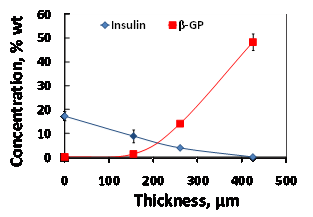STEM CELLSThe increasing recognition of the nature of stem cells has opened up new avenues in terms of their potential therapeutic applications including tissue engineering. Adult stem cells, such as adipose derived stem cells (ADSC), have been found to develop into multiple types of specialized cells including adipogenic, chondrogenic, myogenic, and osteogenic cells when induced with appropriate biofactors (Zuk et al., 2002). In the context of engineering of tissue-tissue interfaces, ADSC appear as a promising cell source provided that appropriate biofactors be localized into the tissue engineering scaffolds in a controlled fashion to enable the differentiation of ADSC into specialized cells at respective locations of the scaffolds. In cartilage-to-bone interface applications, for example, ADSC can be differentiated into cartilage- and bone-specific cells (chondrocytes and osteoblasts, respectively) in a spatially organized manner using a scaffold incorporated with graded concentrations of insulin and beta-glycerolphosphate (β-GP), which are the known biofactors for chondrogenic and osteogenic differentiation. Figure 1A and 1B, below, depict the depth-dependent concentration distributions of insulin and β-GP in a fibrous scaffold, and distribution of chondrogenic phenotype developed from ADSC, respectively.
|

|
A |

|
Figure 1. (A) Concentration distribution of insulin and β-GP over the thickness of electrospun polycaprolactone mesh, and (B) immunostaining for the distribution of chondrocytic cells as a function of thickness using FGFR3 chondrogenesis marker. (Source: Erisken et al. Tissue Eng Part A, 2011) |
|
B |
|
Insulin rich side |
|
β-GP rich side |
|
Useful Links: · Sources, characteristics and promises of stem cells (Link). · Diseases that may currently be treated with stem cells. · Clinical trials under progress to treat a specific disease using stem cells. |
|
Cevat Erisken, Ph.D. |
|
TOBB University of Economics and Technology, Biomedical Engineering Department |





